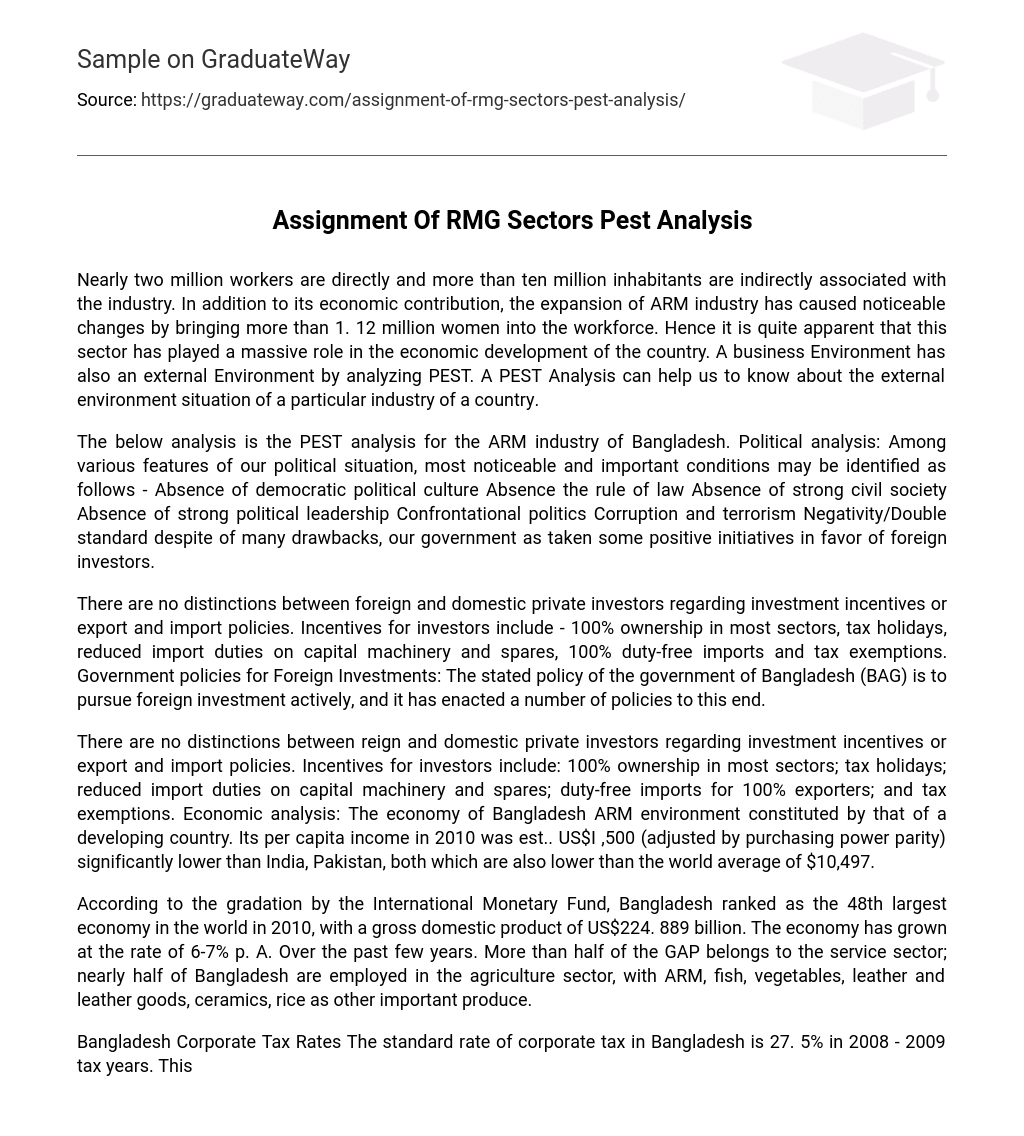Nearly two million workers are directly and more than ten million inhabitants are indirectly associated with the industry. In addition to its economic contribution, the expansion of ARM industry has caused noticeable changes by bringing more than 1. 12 million women into the workforce. Hence it is quite apparent that this sector has played a massive role in the economic development of the country. A business Environment has also an external Environment by analyzing PEST. A PEST Analysis can help us to know about the external environment situation of a particular industry of a country.
The below analysis is the PEST analysis for the ARM industry of Bangladesh. Political analysis: Among various features of our political situation, most noticeable and important conditions may be identified as follows – Absence of democratic political culture Absence the rule of law Absence of strong civil society Absence of strong political leadership Confrontational politics Corruption and terrorism Negativity/Double standard despite of many drawbacks, our government as taken some positive initiatives in favor of foreign investors.
There are no distinctions between foreign and domestic private investors regarding investment incentives or export and import policies. Incentives for investors include – 100% ownership in most sectors, tax holidays, reduced import duties on capital machinery and spares, 100% duty-free imports and tax exemptions. Government policies for Foreign Investments: The stated policy of the government of Bangladesh (BAG) is to pursue foreign investment actively, and it has enacted a number of policies to this end.
There are no distinctions between reign and domestic private investors regarding investment incentives or export and import policies. Incentives for investors include: 100% ownership in most sectors; tax holidays; reduced import duties on capital machinery and spares; duty-free imports for 100% exporters; and tax exemptions. Economic analysis: The economy of Bangladesh ARM environment constituted by that of a developing country. Its per capita income in 2010 was est.. US$I ,500 (adjusted by purchasing power parity) significantly lower than India, Pakistan, both which are also lower than the world average of $10,497.
According to the gradation by the International Monetary Fund, Bangladesh ranked as the 48th largest economy in the world in 2010, with a gross domestic product of US$224. 889 billion. The economy has grown at the rate of 6-7% p. A. Over the past few years. More than half of the GAP belongs to the service sector; nearly half of Bangladesh are employed in the agriculture sector, with ARM, fish, vegetables, leather and leather goods, ceramics, rice as other important produce.
Bangladesh Corporate Tax Rates The standard rate of corporate tax in Bangladesh is 27. 5% in 2008 – 2009 tax years. This is the standard corporate tax rate applicable to publicly traded companies in Bangladesh, a list including tax rates for other corporations are as follows: Publicly Traded Company publicly Traded Company 27. 5% Non- 37. 5% Bank, Insurance & Financial Company 45% Mobile Phone Operator Company If any publicly traded company declares more than 20% dividend, 10% rebate on total tax is allowed.
Social Companies are facing the challenges of adapting effectively to the changing environment in the context of globalization and in particular in the export sector in Bangladesh. Although Consumer Rights Movement, enforcement of government regulations and a structured view regarding the economic importance of Social responsibility are not yet so widespread in the corporate world in Bangladesh, companies have gradually attaching more importance to Social responsibility in the local market as well.
They are increasingly aware that Social responsibility can be of direct economic value. Companies can contribute to social and environmental objectives, through integrating Social responsibility as a strategic investment into their core business strategy, management instruments and operations. This is an investment, not a cost, much like quality management. So, business organizations can thereby have an inclusive financial, commercial and social approach, leading to a long term strategy minimizing risks linked to uncertainty.
Technological The need for faster technological development is increasingly felt in Bangladesh. Development plans of Bangladesh have emphasized science and technological research to develop technologies through adoption of imported technology as well as development of indigenous technologies. As the country is heavily dependent on imported technologies, proper planning is required or its effective transfer through acquisition, assimilation and adoption.
A National Science and Technology Policy has been formulated and adopted by the Government. It has laid down the directions for S and T activities and research, institutional and manpower development. Dissemination and documentation facilities. The National Council for Science and Technology (NCSC) determines S and T policies, reviews the activities of different institutions and provides direction towards S and T research and activities. So, These are the brief form of PEST analysis of ARM sectors of Bangladesh.





